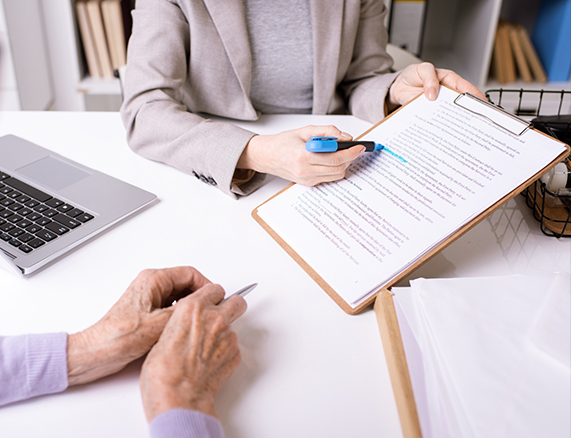• Cracked or Uneven Pavement:
Overtime, the natural wear and tear, shifting ground or invasive tree roots can lead to cracked and uneven surfaces, increasing the risk of a trip and fall on an uneven sidewalk.
• Weather-Related Hazards:
Ice, snow, rain or wet leaves can turn a seemingly harmless sidewalk into a dangerous pathway, especially during colder seasons.
• Obstructions:
Objects that can obstruct normal walking routes, like scooters, bicycles, and fallen branches, force pedestrians to maneuver dangerously.
• Poor Lighting:
Hazards may be hidden on poorly lit sidewalks, making them dangerous to navigate at night and increasing the risk of fall.
• Loose Gravel or Sand:
Construction projects and erosion can leave loose gravel or sand behind, creating an unstable walking surface.
You may be wondering who would be liable in a sidewalk fall lawsuit. Several parties may be liable if you slip and fall on a broken sidewalk.
Cracked or Uneven Pavement:
If a sidewalk hazard is linked to an adjacent private property, the owner may be liable for failing to address the danger.
City or Municipality:
The local government or city is often responsible for sidewalk maintenance. Proving negligence on the part of a municipality fairly challenging but necessary for securing compensation. An experienced trip and fall lawyer can assist in determining who is liable.
Third-Party Vendors:
Companies responsible for maintenance or street cleaning may share liability if they neglect their duties, such as failing to clear debris or repair damage.
To hold a party accountable, you must demonstrate that they failed to uphold their duty of care:
Duty of Care: Both municipalities and property owners are legally required to maintain safe sidewalks.
Breach of Duty: This occurs when a property owner ignores reported damage or fails to clear ice promptly.
Causation and Damages: You must prove that the breach directly caused your injuries and quantify the impact on your life, from medical expenses to lost wages.
An experienced trip and fall accident lawyer, like those with the NYC TRIAL LAWYERS GROUP, can help you protect your legal rights.
Documenting your injuries immediately is crucial, as delays can weaken your case and compromise your health. Even if your injuries don’t show symptoms right away, it is important to prioritize your health.
Report the Incident
Depending on the location of the incident, report the hazard to city officials, law enforcement, or property owners. Always ask for an incident report, which can be official accident documentation.
Gather Evidence
Take photographs of the accident scene, collect witness information, and document relevant details.
Seek Legal Advice
A trip and fall lawyer can help you navigate complex liability issues, especially when dealing with government entities.
Overtime, the natural wear and tear, shifting ground or invasive tree roots can lead to cracked and uneven surfaces, increasing the risk of a trip and fall on an uneven sidewalk.
Ice, snow, rain or wet leaves can turn a seemingly harmless sidewalk into a dangerous pathway, especially during colder seasons.
Objects that can obstruct normal walking routes, like scooters, bicycles, and fallen branches, force pedestrians to maneuver dangerously.
Hazards may be hidden on poorly lit sidewalks, making them dangerous to navigate at night and increasing the risk of fall.
Construction projects and erosion can leave loose gravel or sand behind, creating an unstable walking surface.
You may be wondering who would be liable in a sidewalk fall lawsuit. Several parties may be liable if you slip and fall on a broken sidewalk.
If a sidewalk hazard is linked to an adjacent private property, the owner may be liable for failing to address the danger.
The local government or city is often responsible for sidewalk maintenance. Proving negligence on the part of a municipality fairly challenging but necessary for securing compensation. An experienced trip and fall lawyer can assist in determining who is liable.
Companies responsible for maintenance or street cleaning may share liability if they neglect their duties, such as failing to clear debris or repair damage.
To hold a party accountable, you must demonstrate that they failed to uphold their duty of care:
An experienced trip and fall accident lawyer, like those with the NYC TRIAL LAWYERS GROUP, can help you protect your legal rights.
To protect your health and strengthen a sidewalk fall lawsuit, there are several steps to take:
Documenting your injuries immediately is crucial, as delays can weaken your case and compromise your health. Even if your injuries don’t show symptoms right away, it is important to prioritize your health.
Depending on the location of the incident, report the hazard to city officials, law enforcement, or property owners. Always ask for an incident report, which can be official accident documentation.
Take photographs of the accident scene, collect witness information, and document relevant details.
A trip and fall lawyer can help you navigate complex liability issues, especially when dealing with government entities.
Overtime, the natural wear and tear, shifting ground or invasive tree roots can lead to cracked and uneven surfaces, increasing the risk of a trip and fall on an uneven sidewalk.

Ice, snow, rain, or wet leaves can turn a seemingly harmless sidewalk into a dangerous pathway, especially during colder seasons.
Objects that can obstruct normal walking routes, like scooters, bicycles, and fallen branches, force pedestrians to maneuver dangerously.


Hazards may be hidden on poorly lit sidewalks, making them dangerous to navigate at night and increasing the risk of a fall.
Construction projects and erosion can leave loose gravel or sand behind, creating an unstable walking surface.
Types of Injuries From Slip and Fall Accidents